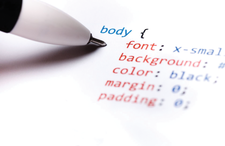Making the most out of Cascading Style Sheets
Command Line – CSS

© Lead Image © photovibes, 123RF.com
Cascading Style Sheets can provide a sophisticated layout for articles and books. Here are a few tips to get you started.
If you have created HTML or JavaScript in the last two decades, you probably have a nodding familiarity with Cascading Style Sheets (CSS) [1]. Not only is the CSS stylesheet language commonplace on the Internet, but popular ebook formats like EPUB and MOBI use it as well. Moreover, because CSS is human-readable, if you know English, you can understand much of what is being done without learning the details. However, a formal look at CSS is likely to reveal missed details, not least of which is the number of options it provides.
CSS keeps format and content separate. Initially, markup languages like HTML were designed to do the same, but the distinction became blurred (if you are old enough, you may remember the infamous HTML blink tab). CSS was intended to restore the distinction by being a stylesheet that gave designers control over how pages are viewed. CSS has been only partly successful, because different web browsers continue to display some elements differently and to allow readers to override CSS with their own preferences. All the same, CSS remains popular, if only because most designers prefer to have some formatting control.
At any rate, CSS continues to be a standard feature of modern computing. Its specifications are developed and maintained by the World Wide Web Consortium (W3C), which also provides a CSS validation service [2]. However, be aware that different CSS uses, such as ebook publication on Amazon or Lulu, often have their own, sometimes arbitrary, standards for CSS stylesheets. A given stylesheet can be valid by W3C standards yet still fail to be accepted by a given publisher. It's time, though, for a closer look at CSS constructions.
[...]
Buy this article as PDF
(incl. VAT)
